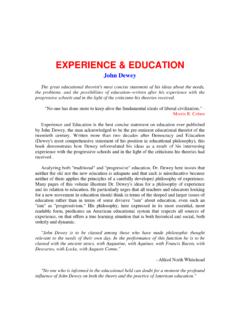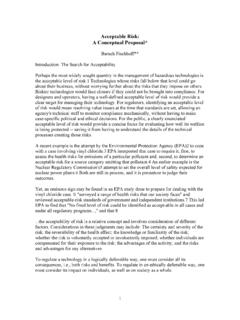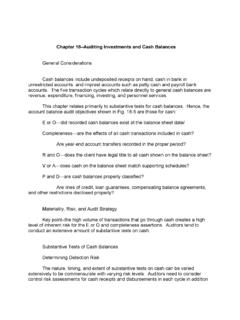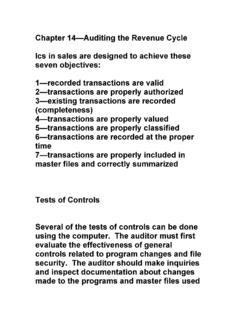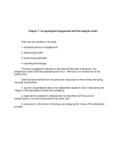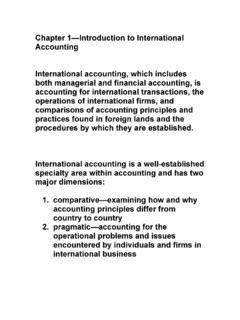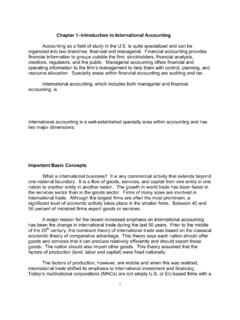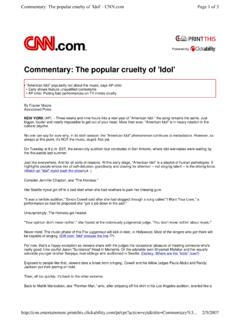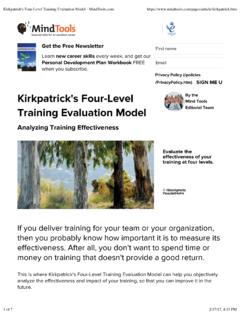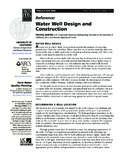Transcription of Chapter 6--Audit Evidence, Audit Objectives, Audit ...
1 Chapter 6--Audit Evidence, Audit objectives , Audit Programs and Working Papers Top-Down vs. bottom -Up Audits Top-down Audit evidence focuses the auditor s attention on obtaining an understanding of the business and industry, management s goals and objectives , how management uses its resources to attain those goals, the organization s competitive advantage in the market, core business processes, and the resulting earnings and cash flows. Top-down Audit procedures provide evidence about the client s strategic business risks, how management is responding to those risks, and the viability of the entity. The auditor integrates all information about the client and client s industry to form expectations about the financial statements. bottom -up Audit evidence focuses on directly testing transactions, account balances, and the systems that record the transactions and resulting account balances.
2 In the end, the auditor develops an Audit strategy that blends a combination of top-down and bottom -up evidence. Important Decisions About Audit Evidence Four important decisions are made about the scope and conduct of the Audit : 1 nature of Audit tests This refers to the type and effectiveness of the Audit test. Audit procedures should provide data about the competitive performance of an entity. 2 timing of Audit tests Timing refers to when the auditor performs Audit tests and draws conclusions. Audit testing at an interim date may permit early consideration of important matters affecting the year-end financial statements. Many matters involving Audit planning, obtaining an understanding of internal control, assessing control risk, and application of substantive tests to transactions, can be done prior to the balance sheet date.
3 3 extent of Audit tests The extent of Audit procedures relates to the auditor s decision about how much Audit evidence to obtain. More evidence is needed to achieve a low level of detection risk than high level of detection risk. 4 staffing the Audit Auditors should be assigned to tasks and supervised commensurate with their level of knowledge, skill, and ability so that they can evaluate the evidence they are examining. Assignments such as obtaining an understanding of internal controls, confirming receivables, testing transactions, or testing the application of GAAP, which are straightforward, might be assigned to entry-level staff. Specific Audit objectives and Audit Evidence An auditor usually identifies specific Audit objectives for each financial statement account. The objectives stem from the assertions made by management in the financial statements.
4 Management s Financial Statement Assertions and Audit objectives SAS 31 says there are 5 types of management assertions: 1--existence or occurrence 2--completeness 3--rights and obligations 4--valuation or allocation 5--presentation and disclosure Audit Evidence, Corroborating Information and Audit Procedures Every auditor must determine the appropriate amount of evidence to collect to be satisfied that the components of the financial statements and the overall statements are fairly stated. By now, you should be familiar with the basic elements of underlying accounting data identified in Fig. 6-3 on page 201. However, underlying accounting data alone are not sufficient support for the financial statements. Auditors should design Audit procedures to obtain corroborating information.
5 Let us consider various types of Audit evidence which constitute corroborating information. Types of Corroborating Audit Evidence There are 7 broad categories of evidence from which the auditor can choose: 1--physical examination 2--confirmations 3--documentation 4--analytical evidence 5--written representations 6--mathematical evidence 7--oral evidence 8--electronic evidence Types of Audit Procedures 1--Analytical procedures 2--Inspecting 3--Confirming 4--Inquiring 5--Counting 6--Tracing 7--Vouching 8--Observing 9--Reperforming Computer-Assisted Auditing Techniques May assist in doing several procedures.. Evaluation of evidence obtained An auditor needs a preponderance of persuasive evidence for each material financial statement assertion to have a reasonable basis for an opinion.
6 When a reasonable basis exists an unqualified, qualified or adverse opinion will be issued. If no reasonable basis exists then a disclaimer of opinion will be issued. Relationship Among Audit Procedures, Types of Evidence and Assertions Let us consider the relationship among Audit procedures, types of evidence, and assertions shown in Fig. 6-7. Tracing, vouching, and inspecting involve the use of documentary evidence. Inspecting could involve the use of physical evidence as do the procedures of counting and observing. Inquiring will yield evidence in the form of written or oral representations. The better you understand the examples in Fig. 6-7 the better you will understand the practice of auditing. Electronic Data Processing and Audit Procedures In certain entities, accounting data and corroborating evidential matter are available only in electronic form.
7 Other entities use Electronic Data Interchange (EDI). Business is transacted completely in electronic format with no paper trail to evidence economic events. Certain electronic evidence may exist at a certain point in time. However, such evidence may not be retrievable after a specified period of time. The auditor needs to consider the implications for the Audit of electronic evidence. The auditor should evaluate whether client practices impact material account balances and transaction classes, and assess the resulting implications for the nature, timing, and extent of Audit procedures. If a client maintains records in electronic form, and the auditor can directly access electronic records, it may have significant implications for the extent of Audit procedures. For example, the auditor may be able to subject 100% of the transactions in a population to being screened by the computer for a particular characteristic.
8 The auditor s application of computer-assisted Audit techniques to electronic data files has allowed Audit strategies where the auditor can target procedures on high-risk subpopulations. Audit Programs Audit program states the Audit procedures that the auditor believes are necessary to accomplish the objectives of the Audit . The Audit program also documents Audit strategy. Figure 6-8 on page 212 provides an overview of the types of tests included in an Audit program: analytical procedures initial procedures tests of accounting estimates usually involve substantive tests of balances. Evaluating the reasonableness of accounting estimates included in the financial statements usually requires an understanding of the business and industry. tests of controls are tests of the internal controls that are dictated by the Audit strategy.
9 Tests of transactions are substantive tests that primarily involve tracing or vouching transactions based on the underlying documentary evidence. tests of presentation and disclosure evaluate the fair presentation of disclosures required by GAAP. Figure 6-9 on page 213 provides an example of an Audit program related to substantive tests of A/R. Remember, however, that as the Audit progresses, changed conditions may make it necessary to modify planned Audit procedures. Working Papers Working paper--records kept by the auditor of the procedures applied, the tests performed, the information obtained, and the pertinent conclusions reached in the Audit . Objective of working papers--to aid the auditor in providing reasonable assurance that an adequate Audit was done in accordance with GAAS. Working papers give a basis for planning the Audit , a record of the evidence accumulated, results of tests, data for determining the proper type of Audit report and a basis for review by supervisors.
10 Contents and Organization of Working Papers Each CPA firm establishes its own approach to preparing and organizing working papers. The papers include such diverse planning information as the evaluation of internal control, a time budget for individual Audit areas, the Audit program, and the results of the prior year s Audit . The working papers are the primary frame of reference used by supervisory personnel to evaluate whether sufficient competent evidence was accumulated to justify the Audit report. The working papers can also serve as the basis for preparing tax returns, filings with the SEC, and other reports; a source of information for issuing a management letter to the client for improving operations, a frame of reference for training personnel and an aid in planning and coordinating subsequent audits. Permanent files--are intended to contain data of a historical or continuing nature pertinent to the current examination.
